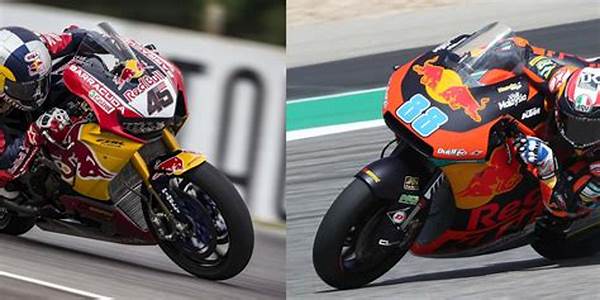Differences Between Motogp And Superbike Motorcycles

Ah, the roaring engines, the smell of burning rubber, and the electrifying atmosphere of motorcycle racing—it’s an adrenaline rush like no other! For those of us obsessed with speed and performance, the names MotoGP and Superbike resonate profoundly. These two racing worlds, though seemingly similar, house intricate differences. Ready to delve into these high-speed realms? Strap on your helmets, because this journey is going to get fast and fascinating!
Read More : Sky Sports News Is Your Source For The Most Up-to-date Sports Information
Understanding the differences between MotoGP and Superbike motorcycles isn’t just for the racing aficionados. Whether you’re a casual observer, a tech geek, or someone looking to impress your motorcycle friends at the next gathering, knowing these distinctions is intriguing and enlightening. Welcome to the world where precision meets danger and where motorcycles transform into beasts on wheels.
Unraveling the Mysteries: Differences Between MotoGP and Superbike Motorcycles
The Core of MotoGP: Prototype Monsters
MotoGP motorcycles are the thoroughbreds of the racing world. Built purely for speed, they are the epitome of cutting-edge technology. These bikes are custom-made, each a masterpiece of engineering that you’d consider as much a work of art as a vehicle. MotoGP bikes, unlike superbikes, are not commercially available, which is part of their allure and exclusivity. They run on purpose-built circuits, with top speeds that can exceed 350 km/h (approximately 217 mph).
The wild thing about MotoGP is how the rules encourage innovation. Teams invest millions in research and development, creating bikes that push the boundaries of physics and engineering. The engines, aerodynamics, and electronic systems are evolving year after year, outsmarting and outpacing competitors—and that’s the real beauty of MotoGP.
The Power of Superbikes: Modified Production Machines
In contrast, superbikes start their lives as production models. Yes, those same motorcycles you see at local dealerships, albeit heavily modified. These bikes race in the Superbike World Championship, where they demonstrate the power of machines that are accessible to the public—well, with a few tweaks here and there.
Superbikes do not have the extreme limitations on design that MotoGP bikes do, but they must comply with a strict set of rules that ensure a level playing field. The beauty here lies in watching recognizable bikes, from Ducati Panigales to Kawasaki Ninjas, compete head-to-head on famous circuits across the globe. They provide a relatable thrill, perhaps more personal, because you might just ride their cousins to work!
Technical Aspects: Differences That Matter
The differences between MotoGP and Superbike motorcycles extend into their mechanical and electronic features. MotoGP bikes typically feature more advanced electronics, including seamless shift transmissions and sophisticated rider aids like traction control and anti-wheelie systems. The materials used in these marvels of technology include carbon fiber and other lightweight composites.
Superbikes, on the other hand, generally have fewer electronic gadgets. They emphasize a more direct and raw connection between the rider and the machine. The modifications on superbikes are extensive, covering suspensions, brakes, and engine tuning, but they remain true to their production roots.
Read More : Tnt Sports Updates Breaking Sports News For 2025
Diving Deeper: Detailed Insights into the Differences
Intriguing Distinctions: What Sets MotoGP Apart?
The differences between MotoGP and Superbike motorcycles are not merely technocratic—they reflect different philosophies of racing. MotoGP is the crescendo of speed and innovation, constantly challenging what is possible. It’s a laboratory on wheels where victories are often born from creating something unprecedented. The allure is in the limitless possibilities, where every turn, every lap, is a step into the unknown.
For Superbike racing, the charm lies in its grounded reality. It’s a celebration of what is possible within the everyday realm of motorcycle engineering. The modifications, while impressive, illustrate the capability of machines that one can, in essence, own and ride. It’s this connection to the consumer experience that gives Superbikes their allure—they represent the pinnacle of what those same commuters, hobbyists, and enthusiasts can aspire to.
Summary: The Essence of Two Worlds on Two Wheels
If you’ve ever wondered why the debates rage about which of these two leagues is superior, that’s because both have their own unique selling points. MotoGP, with its stratospherically high speeds, unrestricted designs, and mind-boggling technology, caters to those who seek the ultimate in motorcycle racing. It stands as an exclusive arena where manufacturers pioneer technologies that shape the future of motorcycling.
Superbikes, with their heart in the real world and tires on the race track, offer a visceral connection between professional racing and the everyday biker. This world showcases the potentialities of production bikes, tweaking them to new heights while maintaining an inherent accessibility that MotoGP lacks. A race weekend in the Superbike world seems like a distant cousin’s homecoming—a celebration where everyone, from casual fans to lifetime bikers, find a niche to enjoy.
The choice between these two is not about deciding which is better; rather, it is about recognizing and appreciating the different thrills that each brings to racing. Whether you find yourself drawn to the avant-garde universe of MotoGP or the relatable realm of Superbikes, the heart-pounding action promises to keep you on the edge of your seat, race after thrilling race. It’s not just about speed or technology; it’s about the stories told on each podium, the rivalries, the triumphs, and the evergreen allure of the motorcycle. So, pick your team, wear your colors, and let the races begin!



